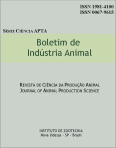Effect of doses of poultry compost on chorophyll and flavonoids of Brachiaria brizantha brs Piatã
Keywords:
flavonoids, Piatagrass, poultry litterAbstract
In 2012, Brazil produced 12.6 million metric tons of chicken meat, generating 10.3 tons of poultry litter. Compost made from such organic waste can be used as a low-cost bio fertilizer, especially as nitrogen and phosphorus source. The compost can increase pastures quality by giving photosynthetic improvement and altering amounts of chlorophyll and flavonoids. There is little information about the relationship between chlorophyll a or b and flavonoids in Brachiaria brizantha Piata. The flavonoid is a kind of polyphenol compound which protects the plant against UV-B radiation and pathogen attack, it acts as attractants for pollinators, as signal molecules for initiating plant-microbe symbiotic associations and antioxidant activity. The objective of the present study was verified the effects of poultry litter compost doses on the chlorophyll and flavonoid contents in Piata grass leaves. The experiment was performed at the Animal Nutrition and Pasture Center €“ Instituto de Zootecnia €“ Nova Odessa, SP, from May to July 2013, on a Haplorthox soil (pHCaCl2= 4.9), cultivated with Piata grass (Brachiaria brizantha, Stapf), without liming. The treatments consisted of five compost doses: 0; 20; 40; 60 and 120 Mg ha-1, with the following chemical composition (%): 2.88 of N, 3.85 of P2O5, 2.50 of K2O, 9.06 of Ca and 1.16 of Mg. The experimental design was on randomized blocks with five replications. Chlorophyll amounts and flavonoids were determined by sampling the third medium of the leaf blade from a third of the expanded leaf from the apical using the Dualex and the chlorophyll a and b which were determined by the Lichtenthaler & Wellburn (1983) method. Results showed that chlorophyll a was similar in all doses (average of 18.3 micrograms per cm2),therefore for chlorophyll b the amount was significantly increased from 7.3 to 22.4 micrograms per cm2 (P<0.01)when compared to no addition of poultry litter. The fast nitrogen liberation from poultry litter resulted on a better metabolism and better chlorophyll b synthesis, indicating more mass production. Flavonoid contents decreased on the leaves of Brachiaria brizantha Piatàwith the addition of poultry litter, from 1.39 to .81 micrograms per cm2, with respectively zero 120 Mg ha-1 of compost. Flavonoid content was negatively correlated to total chlorophyll, adjusted by the quadratic equation: Flavonoids= - 0.0353Chlorophyll + 2.29 (R2= 0.87). The use of increasing doses of poultry litter reduced the foliar flavonoids concentration.Downloads
Downloads
Published
Issue
Section
License
Os autores não serão remunerados pela publicação de trabalhos, pois devem abrir mão de seus direitos autorais em favor deste periódico. Por outro lado, os autores ficam autorizados a publicar seus artigos, simultaneamente, em repositórios da instituição de sua origem, desde que citada a fonte da publicação original seja Boletim de Indústria Animal. A revista se reserva o direito de efetuar, nos originais, alterações de ordem normativa, ortográfica e gramatical, com vistas a manter o padrão culto da língua e a credibilidade do veículo. Respeitará, no entanto, o estilo de escrever dos autores. Alterações, correções ou sugestões de ordem conceitual serão encaminhadas aos autores, quando necessário. Nesses casos, os artigos, depois de adequados, deverão ser submetidos a nova apreciação. As opiniões emitidas pelos autores dos artigos são de sua exclusiva responsabilidade. Todo o conteúdo deste periódico, exceto onde está identificado, está licenciado sob a Licença Creative Commons Attribution (CC-BY-NC). A condição BY implica que os licenciados podem copiar, distribuir, exibir e executar a obra e fazer trabalhos derivados com base em que só se dão o autor ou licenciante os créditos na forma especificada por estes. A cláusula NC significa que os licenciados podem copiar, distribuir, exibir e executar a obra e fazer trabalhos derivados com base apenas para fins não comerciais.













